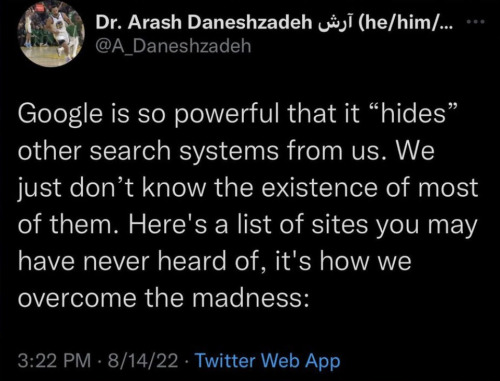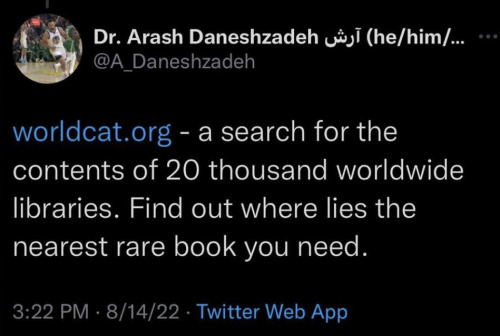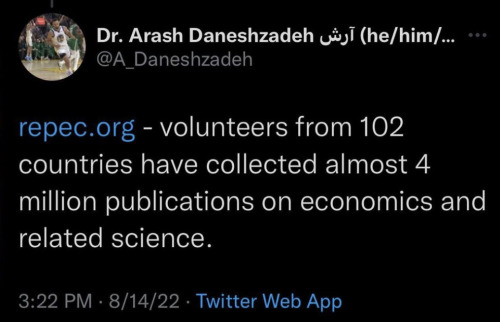Refseek.com


refseek.com

www.worldcat.org/

link.springer.com

http://bioline.org.br/

repec.org

science.gov

pdfdrive.com
More Posts from Madadreferencearchive and Others
So my sister wants to start sewing more, because
a. She’s 5′ 11″ and can never find pants long enough for her legs or shirts long enough for her arms.
b. She hates synthetic fibers as much as I do and it’s difficult to find natural fiber clothes that aren’t made of cotton
c. She’s a biologist and would physically fistfight microplastics if given half a chance
So her gift from mom and dad for her birthday was a sewing machine. Not a super expensive one but a good solid serviceable one.
And recently she asked “So where do I GET wool or linen and thread that isn’t polyester” and mom was like ‘go ask your sister’
And I, of course, crashed into the group text like “GET A PEN I HAVE WEBSITES FOR U” and honestly I’m thrilled about this
I’ve said this before and I’ll say it again but it is absolutely an example of civilizational inadequacy that only deaf people know ASL
“oh we shouldn’t teach children this language, it will only come in handy if they [checks notes] ever have to talk in a situation where it’s noisy or they need to be quiet”
I have an essay brewing in my head constantly about lawns. Which, well, unsurprising, since I post about how I hate lawns all the time, but I think the "lawn" and "landscaping" centered way of thinking about Places Outside is a Bigger Thing that Connects to Other Things
(What isn't? Having ideas about concepts is always like this.)
I will introduce my ideas by a situation where they apply: Sometimes life-forms mimic other life forms. One form of mimicry is called Vavilovian mimicry, where weed species in crops grown by humans evolve over time to be more similar to the crops.
Vavilovian mimicry basically helps weeds survive because the weeds are adapted to the care-taking regimen of the crops, and because the human caretakers of the crop can have a hard time telling them apart, which means they might say "Ehh...I'll wait until it grows up so I can be sure I'm not pulling up my crop."
I think there's something similar at work among flower gardens and landscaping...but it's different.
Regular people don't know the name of every plant that might possibly grow in their flower beds, and they often pull up plants they don't know just because they don't know them. They sometimes say they pull up a plant that "looks weedy" or "looks like a weed."
I think to myself...what does "weedy" look like?
This question collided unexpectedly in my brain with an insight I had about invasive species that I could not explain.
I have to get rid of a lot of Callery pear, wintercreeper, honeysuckle, burningbush, privet, English ivy, and other plants that are invasive where I live. And strangely- many invasive plants look similar in ways they don't share with very many native species. They tend to have small, round or squat, glossy leaves, and they tend to have a very dense growth habit.
I can think of several possible explanations: Maybe these species thrive in North America today because of the loss of controlled burning, but their characteristics look so distinct next to native species because they relate to things that would make a species fire-intolerant? This doesn't seem quite right, since it doesn't predict level of fire-adaptedness in native species.
Another explanation is better: they were selected for these traits by humans for their usefulness in landscaping. Dense growth habit would be useful for creating hedges or ground covers. This is why many invasives were originally planted, right? And small leaves might feel or be perceived as less "messy" when they fall.
But I think this is a clue to something else going on. What does "weedy" look like?
Some plants go on one side of "weeds vs. flowers" and some on the other, and it's almost totally arbitrary...so how do gardeners make the call so decisively?
I think about the commonest "landscaping" plants- Knock Out roses, hostas, petunias, begonias, boxwoods and so on- they share a lot of the characteristics mentioned above. Shiny or at least smooth, typically small and squat leaves, dense and compact growth habit.
Then I think about some of the commonest and most important "weedy" native wildflowers, such as goldenrods, asters, milkweeds, Joe-Pye weed, ironweed, sunflower. They all differ from the above in at least one striking way. Mostly, they have hairy leaves and stems, long and thin leaves, and a tendency to grow up tall before blooming. Milkweed has smooth leaves, but its leaves are long and very big. Hmm...
And I think I can guess where this is coming from.
Landscaping and garden designs often look like this


See how the plants are drawn and arranged to cover a space in two dimensions, mostly not overlapping with each other? This is very easy to plan and design. And those common landscaping plants I mentioned—hostas, Knock Out roses, boxwoods, and so on—are very good at acting just like a two-dimensional representation of them does. Just look, you can see them:

Now look at those important native wildflowers I mentioned:
Goldenrod

Ironweed

Milkweed

These guys don't fill much space in a horizontal plane, they go straight up. They don't exclude other plants from very much space either. Plants could grow under them and among them. So they're not very good for "filling up" space, and their opener, lankier, less dense shape doesn't do a good job at blocking other plants from growing.
In a garden of North American prairie- or meadow-adapted plants, the plants wouldn't exclude each other and stay within their designated spots because they're evolved to intermix with a great variety of plants.

"Separateness" is a big part of the typical "landscape" aesthetic. These plants are very neatly separate from each other. This is what looks "neat" and well-kept to us...the opposite of "weedy."
This could mean our garden and flower beds are affected by a selective pressure a lot like the Vavilovian mimicry situation. But instead of weeds being selected to look like intentionally grown plants, the intentionally grown plants are being selected to look different from weeds.
The subtle difference makes perfect sense. In a field, the rule is "leave the plant there if you're unsure" because that's your food. In a flower bed, the rule is "get rid of the plant if you're unsure" because having weeds is more aesthetically unacceptable than having blank space.
The point is: Ecology needs to be a big part of gardening and landscaping, because you are DOING ecology. Even if you don't know the evolutionary principles, you're acting them out.
Just like the ineffable preferences of female birds give the males weird elaborate display structures, ineffable aesthetic "senses" that govern our "built" world slowly turn it into something weird.
I’ve said this before and I’ll say it again but it is absolutely an example of civilizational inadequacy that only deaf people know ASL
“oh we shouldn’t teach children this language, it will only come in handy if they [checks notes] ever have to talk in a situation where it’s noisy or they need to be quiet”
resources for staying safe online
always important, but i feel like especially recently. particularly stuff that’s a bit more than just the usual “don’t post personal info”
feel free to share this post on twitter or anywhere else, staying safe is important
justdeleteme.xyz - direct links to delete accounts
how a photo’s hidden exif data exposes your personal information
have i been pwned? - check if your accounts have been compromised in a data breach. CHANGE ANY ACCOUNT THAT USES THE SAME EMAIL AND PASSWORD
online harassment field manual
form for removing personal information from google (for the eu), see also: “remove your personal information from google”
extreme privacy: what it takes to disappear (personal data removal workbook)
filter lists for ublock origin, and more
restore privacy - online privacy resources center
privacytools.io
online spyware watchdog
how secure is your password?
defensive computing checklist
cloudflare dns
non-technical tips on staying anonymous
webrtc leak shield - chrome, firefox
web safety tutorials by the electronic frontier foundation
crash override network - resources for victims of doxing and online harassment

Want to learn something new in 2022??
Absolute beginner adult ballet series (fabulous beginning teacher)
40 piano lessons for beginners (some of the best explanations for piano I’ve ever seen)
Excellent basic crochet video series
Basic knitting (probably the best how to knit video out there)
Pre-Free Figure Skate Levels A-D guides and practice activities (each video builds up with exercises to the actual moves!)
How to draw character faces video (very funny, surprisingly instructive?)
Another drawing character faces video
Literally my favorite art pose hack
Tutorial of how to make a whole ass Stardew Valley esque farming game in Gamemaker Studios 2??
Introduction to flying small aircrafts
French/Dutch/Fishtail braiding
Playing the guitar for beginners (well paced and excellent instructor)
Playing the violin for beginners (really good practical tips mixed in)
Color theory in digital art (not of the children’s hospital variety)
Retake classes you hated but now there’s zero stakes:
Calculus 1 (full semester class)
Learn basic statistics (free textbook)
Introduction to college physics (free textbook)
Introduction to accounting (free textbook)
Learn a language:
Ancient Greek
Latin
Spanish
German
Japanese (grammar guide) (for dummies)
French
Russian (pretty good cyrillic guide!)
Los Angeles Times! See me, more patients and the studio!
So you may have wondered why Habersham's story followed so quickly on the heels of Lucky the Bear's, and the reason is, it was a bit of a teaser.
Over the past few months, I have been interviewed for almost 2 hours by a reporter for the LA Times. Then a photographer came out to the hospital and took photos of me and the hospital and the patients I had at the time (for another two hours!). And then a few weeks ago, another photographer came out to take portraits of the patients I had then. Including one of Habersham. Then, yesterday, September 10, this appeared as the cover of the LA Times Calendar section:

That's Habersham before his surgery. And a wonderful play on Tears for Fears for the title of the story. :-) There's a two page spread inside the paper, and you can read it, and see a lot (if not all) of the photos online here. If the link doesn't work, you can also go to the LA Times and search "toy hospital" in the search box on the site and you should find the article that way too.
Anyway, as you may imagine, I've been doing a bit of a happy dance about the story all weekend. And I really wanted to share it with all of you because a) I thought you might enjoy the article and b) the reporter found me in part because of this blog which you all have chosen to read and follow and like over the years, so you all deserve thanks for the article too!
beth
What people think why i became a bookbinder: Oh she wants to explore her artistic horizon with those pretty leather bound books of hers. She even gives them out as gifts to her friends. It most likely helps her with anxiety or maybe she just wanted a more special costume made notebook.
Why I actually became a bookbinder: I just illegally downloaded and printed out several of my favourite fanfics and books and started binding them into books cuz I love reading them but looking at screens for too long gives me headaches.

-
 tiredfox-b liked this · 6 days ago
tiredfox-b liked this · 6 days ago -
 imcallingyrbluff liked this · 6 days ago
imcallingyrbluff liked this · 6 days ago -
 ishouldbeoverfanficsbynow reblogged this · 6 days ago
ishouldbeoverfanficsbynow reblogged this · 6 days ago -
 biblically-accurate-milf reblogged this · 6 days ago
biblically-accurate-milf reblogged this · 6 days ago -
 biblically-accurate-milf liked this · 6 days ago
biblically-accurate-milf liked this · 6 days ago -
 roach-witch reblogged this · 6 days ago
roach-witch reblogged this · 6 days ago -
 emma-dennehy-presents reblogged this · 6 days ago
emma-dennehy-presents reblogged this · 6 days ago -
 emma-dennehy-presents liked this · 6 days ago
emma-dennehy-presents liked this · 6 days ago -
 ubikuitous liked this · 6 days ago
ubikuitous liked this · 6 days ago -
 notyourdramaqueen reblogged this · 6 days ago
notyourdramaqueen reblogged this · 6 days ago -
 letsdosomeregicide liked this · 6 days ago
letsdosomeregicide liked this · 6 days ago -
 sukimoto liked this · 6 days ago
sukimoto liked this · 6 days ago -
 princedodo liked this · 6 days ago
princedodo liked this · 6 days ago -
 hatty-cat-360 reblogged this · 6 days ago
hatty-cat-360 reblogged this · 6 days ago -
 hatty-cat-360 liked this · 6 days ago
hatty-cat-360 liked this · 6 days ago -
 enduring-reality reblogged this · 6 days ago
enduring-reality reblogged this · 6 days ago -
 kittyburger liked this · 6 days ago
kittyburger liked this · 6 days ago -
 chadmojito reblogged this · 6 days ago
chadmojito reblogged this · 6 days ago -
 non-beanary-freak reblogged this · 6 days ago
non-beanary-freak reblogged this · 6 days ago -
 thatplanehopperofsigil liked this · 6 days ago
thatplanehopperofsigil liked this · 6 days ago -
 true-meaning-of-smekday liked this · 6 days ago
true-meaning-of-smekday liked this · 6 days ago -
 link-theultimatetimelord reblogged this · 6 days ago
link-theultimatetimelord reblogged this · 6 days ago -
 thefoxlibrary liked this · 6 days ago
thefoxlibrary liked this · 6 days ago -
 dahliaismystrippername reblogged this · 6 days ago
dahliaismystrippername reblogged this · 6 days ago -
 gapinyourteeth liked this · 6 days ago
gapinyourteeth liked this · 6 days ago -
 kbius6 liked this · 6 days ago
kbius6 liked this · 6 days ago -
 ashyguyspage reblogged this · 6 days ago
ashyguyspage reblogged this · 6 days ago -
 eternalparadisearchive reblogged this · 6 days ago
eternalparadisearchive reblogged this · 6 days ago -
 jonjoly liked this · 6 days ago
jonjoly liked this · 6 days ago -
 lokilaufeysonthesilvertongue liked this · 6 days ago
lokilaufeysonthesilvertongue liked this · 6 days ago -
 hauntedbirdhouse liked this · 6 days ago
hauntedbirdhouse liked this · 6 days ago -
 dancinginthemoonslight liked this · 6 days ago
dancinginthemoonslight liked this · 6 days ago -
 milutarelion reblogged this · 6 days ago
milutarelion reblogged this · 6 days ago -
 e7kwlitfsu liked this · 6 days ago
e7kwlitfsu liked this · 6 days ago -
 lvkaszpiszczek liked this · 6 days ago
lvkaszpiszczek liked this · 6 days ago -
 moondustpie liked this · 6 days ago
moondustpie liked this · 6 days ago -
 undaily liked this · 6 days ago
undaily liked this · 6 days ago -
 irreputablyyours reblogged this · 6 days ago
irreputablyyours reblogged this · 6 days ago -
 irreputablyyours liked this · 6 days ago
irreputablyyours liked this · 6 days ago -
 snaccula reblogged this · 6 days ago
snaccula reblogged this · 6 days ago -
 maybejustsomeguy reblogged this · 6 days ago
maybejustsomeguy reblogged this · 6 days ago -
 gato-despeinado reblogged this · 6 days ago
gato-despeinado reblogged this · 6 days ago -
 lesbianmarkhoppus reblogged this · 6 days ago
lesbianmarkhoppus reblogged this · 6 days ago -
 emperatrizdelsol liked this · 6 days ago
emperatrizdelsol liked this · 6 days ago -
 tinyfighterjetski reblogged this · 6 days ago
tinyfighterjetski reblogged this · 6 days ago -
 dearpeopleonthesubway reblogged this · 6 days ago
dearpeopleonthesubway reblogged this · 6 days ago

Hey my main is mad-ad I use this side blog to keep posts I want to save handy and my drafts clear
76 posts